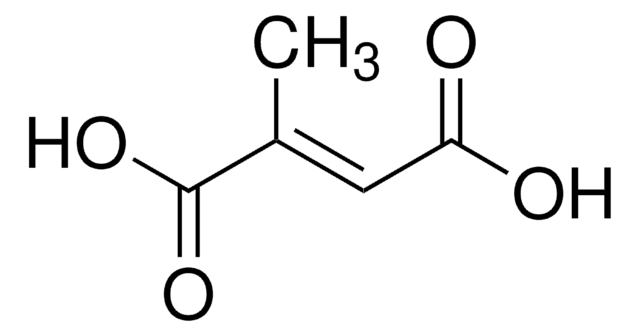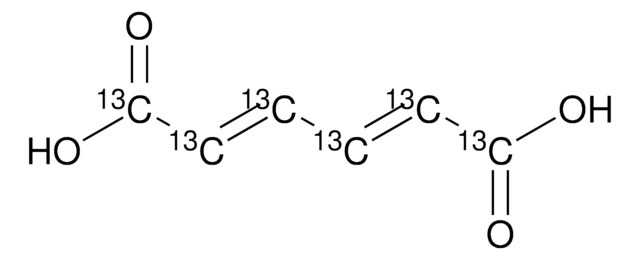15992
cis,cis-Muconic acid
≥97.0% (HPLC)
Synonym(s):
cis,cis-2,4-Hexadienedioic acid
About This Item
Recommended Products
Assay
≥97.0% (HPLC)
mp
194-195 °C (lit.)
SMILES string
OC(=O)/C=C\C=C/C(O)=O
InChI
1S/C6H6O4/c7-5(8)3-1-2-4-6(9)10/h1-4H,(H,7,8)(H,9,10)/b3-1-,4-2-
InChI key
TXXHDPDFNKHHGW-CCAGOZQPSA-N
Related Categories
General description
Application
- Biotechnological production methods: Research highlights various biotechnological approaches to enhance the synthesis of cis,cis-muconic acid, which can serve as a precursor for biodegradable polymers and other bio-based plastics, aligning with sustainable chemical manufacturing goals (Son et al., 2023).
- Industrial application in polymer industry: The potential application of cis,cis-muconic acid in the polymer industry is explored, focusing on its role as a precursor for manufacturing eco-friendly, bio-based plastics, thereby contributing to sustainable industrial practices (Palumbo et al., 2024).
Signal Word
Warning
Hazard Statements
Precautionary Statements
Hazard Classifications
Acute Tox. 4 Oral - Eye Irrit. 2 - Skin Irrit. 2 - STOT SE 3
Target Organs
Respiratory system
Storage Class Code
11 - Combustible Solids
WGK
WGK 3
Flash Point(F)
Not applicable
Flash Point(C)
Not applicable
Personal Protective Equipment
Certificates of Analysis (COA)
Search for Certificates of Analysis (COA) by entering the products Lot/Batch Number. Lot and Batch Numbers can be found on a product’s label following the words ‘Lot’ or ‘Batch’.
Already Own This Product?
Find documentation for the products that you have recently purchased in the Document Library.
Customers Also Viewed
Our team of scientists has experience in all areas of research including Life Science, Material Science, Chemical Synthesis, Chromatography, Analytical and many others.
Contact Technical Service












